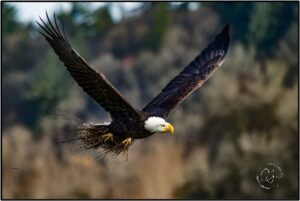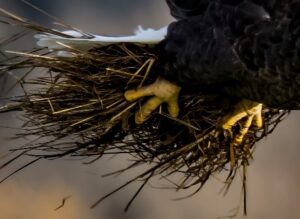
Sitting in my office contemplating this article I was surprised when a Bewick’s wren was tapping on my window. I was REALLY surprised when I realized it was INSIDE my window. It must have come into the house when I had my garage door open this morning. It made its way to the bright windows of my office, struggling to find its way out. I reached to raise the blinds and open the window. The tiny feet wrapped around my finger for a moment before departing. A gift from Mother Nature. That’s what I’ve been thinking about this month on the refuge. There are so many wonders of each season, but I have to say I like this time of year best. Leaves have fallen to expand our view. The skies with sun breaks are incredible. The birds that stay are a hearty group and fun to watch as they focus on food. The coyote pups are getting better at catching what they jump on. This is our season of gift-giving and well wishes to family and friends, while Mother Nature provides wonders for our enjoyment and entertainment, gifting in her own way.


Salad anyone? Last week, from the contact station door I watched a Hairy Woodpecker land at the moss-covered base of one of our cottonwoods and pick away. It was tossing green pieces back over its head littering the sidewalk. I’m pretty sure it wasn’t looking for a salad lunch, but probably any protein goodies that hide under moss. When the woodpecker left, the sidewalk was a mess. I hope it found a tasty morsel. A delightful gift for the day.

I hear something out there: We have had multiple days of dense fog this December. Visitors tend to be scarce or late on those days. But one of the most breathtaking experiences on the Refuge is to watch the fog lift and the sun come through.

Volunteer Carl LaCasse provided this photo: A goose, barely visible, crossing in front of the fog-shrouded sun. As morning progresses, more becomes visible. Sometimes you realize that the Sandhill Cranes you heard are maybe 30 feet away. And then it is green everywhere. It’s like a whole different place.

The Three Wise Owls: December has been a gift of the three owls. A Christmas day visitor was so excited to be back for a visit because he and his son had seen their first owl on Christmas Day eight years ago. He got a new owl this year. Many were happy to welcome back the Short-eared Owls (SEOW) who like to roost in the long grasses at the southern end of the auto tour. SEOWs are open country, ground-nesting species. They inhabit marshes, grasslands, and tundra. They breed in northern climes of North American, Europe and Asia. They are in the PNW and northern plains states year-round. They are considered a partial migrant. Although they may be in an area for multiple years, they are nomadic in their habits and will move when there is variation in small mammal abundance by shifting breeding and wintering sites. Studies of their migration are sparse, so it is hard to say if our SEOWs are part of shifting populations or came from greater distances.
And along the way to see the SEOW, if you’re lucky, you might see our resident Great Horned Owls in the woods or our less frequent visitor, the Barred Owl.

Our Barred Owl is considered non-migratory, preferring deep forests, including riparian habitats. Through the 20th century, it successfully expanded from the east coast across Canada’s boreal forest and down the Pacific Coast into California. However, I wonder why it is choosing to be in our sparse ash forests here. As a generalist predator, it eats a variety of birds up to the size of grouse; small mammals up to the size of rabbits; and amphibians, reptiles, and invertebrates. There is one attraction, there is plenty of food for it on our Refuge.
Of course, our ever-present Great Horned Owl (GHOW). Biggest of all, it lives anywhere in North America except for the arctic-alpine region. And they remain as permanent residents wherever they are. The only exception is during an eruption when food sources fail in the north, and they have to move south to feed. Although they eat a wide range of things, 90% of their diet is mammals. Other birds are the predominant part of the last 10%.

Both Barred Owls and Great Horned Owls are territorial. GHOW will not be real tolerant of a close neighbor during nesting season. But, I couldn’t find any information that said there would be a problem between the two species if they are close together. The only interesting item was about a nest tree occupied by both species documented in Saskatchewan. Who knows what spring will bring if the Barred Owl persists.

Anticipation of future generations: What could more exciting than watching a Bald Eagle carrying nest materials. Volunteer Carl LaCasse captured this fantastic image. The Bald Eagles are indeed sprucing up their nests from last year. This particular one was on the southern end of the auto tour. Its nest can be seen looking east across Lake River. Look at how it grasps the bundle of sticks in its talons, against the tail. Amazing. (Carl is a photographer by profession, having practiced his trade around the world. He is usually volunteering in the contact station on Saturdays. He would be happy to tell you how he can capture these images.)

But back to Bald Eagles. In early December I saw one of another pair carrying a branch, not sticks, longer than its body to a nest that’s to the north. Unfortunately, that nest can only be seen from the Port of Ridgefield. But you can see the adult Bald Eagles moving around near Quigley Lake. When we did the recent Raptor count for December, 6 adult Bald Eagles were found in the hunt zone alone. There is another nest you can see peering west through the trees between numbers 9 and 10. It’s in the trees lining the dike along Bachelor Slough. Not sure if this one is going to be active this year or not. But we can look forward to eaglets this spring from some of these nests.

And the biggest gift of all: Although the summer was so very dry, the heavy rains of Fall have filled our lakes up to the point of having to consider moving water out! But with so much water, we have quite a bit of muddy edges and water at various depths. No freezing as yet has left the lakes and ponds open, a very attractive feeding area for shorebirds. Killdeer, Wilson’s Snipe, Long-billed Dowitcher, Greater Yellowlegs, and (drum roll please) Black-necked Stilt have been feeding on the refuge. According to Birds of the World, in Fall our stilt. “Passes through coastal Washington in early Aug and coastal Oregon mid-Aug to early Sep”. This bird shouldn’t be here now. A quick look through e-bird sightings found only one November sighting on the Refuge in November 2020. This year it was spotted in mid-November by Roger Windemuth when he was doing his weekly bird survey. It has been sighted in the pond opposite the Kiwa Trail entrance almost daily since then. Looking at where it hangs out, it fits its usual habitat requirements of margins of shallow water where there is much marsh growth.

It likes mostly insects and crustaceans, feeding on small creatures that live on or near the surface of water. You can watch how our stilt walks the shallows pecking away as it goes. Sometimes they will also eat aquatic seeds.

Stilts are known to summer in eastern Washington. In winter they move away from most inland areas to the coasts but generally go south from this area. If the winter stays “warm” maybe our stilt will stay around and be ok. We can only hope. Makes you think about climate change. Could this be the first of many stilts? It is a big deal to have this bird here.
I am thankful for these wonderful gifts from Mother Nature this winter. I look forward to the first dusting of snow that spreads magic across the Refuge. Just put on your Pacific Northwest winter gear of warm socks, winter hat, suitable jacket and Bermuda shorts, and come join me on the refuge to find wonderful wildlife and beautiful country. Wishing you many exciting and amazing sightings and experiences on the Refuge this New Year of 2024.
-Susan Setterberg, Ridgefield National Wildlife Refuge Contact Station Volunteer